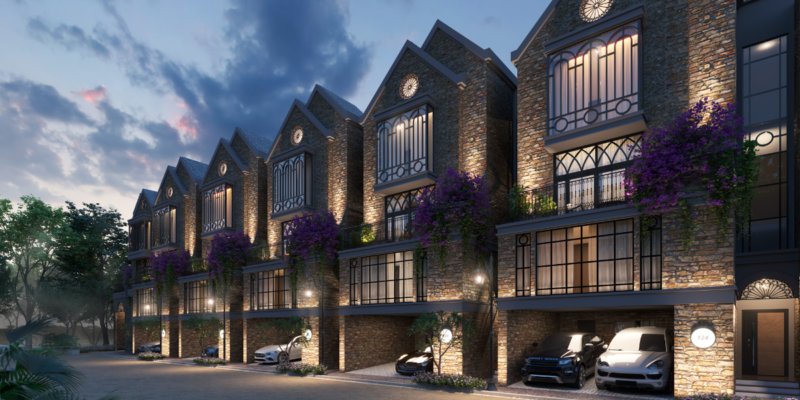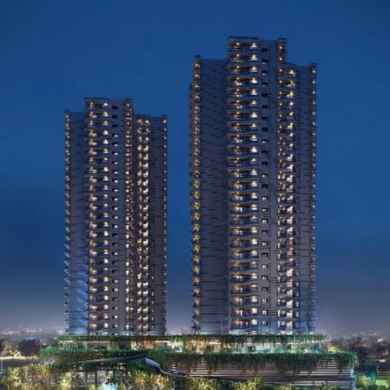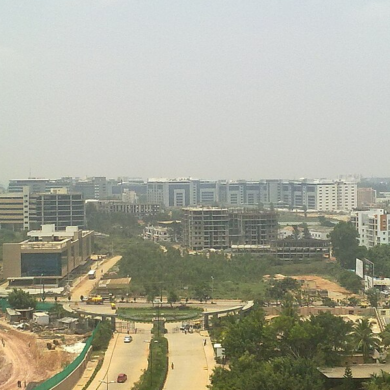
Row house offers a smart blend of privacy, land ownership, and affordability – ideal for buyers seeking independent living with community benefits in growing Indian cities.
What is a row house? Many prospective homebuyers ask this question, while exploring alternatives to apartments and standalone homes. Offering a unique blend of privacy, land ownership, and structured design, row houses have become a preferred choice in India’s fast-evolving residential landscape.
In this blog, you can discover how these residences are designed, why they are gaining traction, and what sets them apart. With a closer look at key features, benefits, and current trends – including an overview of row house price in India – this guide helps you navigate your investment journey with greater clarity.
Table of Contents
Why Row Houses Are Popular in Large Indian Cities
Known for their structured layout and efficient use of land, these homes are increasingly seen as a practical choice for modern living. Understanding row house meaning and why this format appeals to diverse buyer segments is essential to taking an informed decision.
- Efficient Use of Land: Whether in dense urban cores or rapidly growing areas, these houses optimise land usage without compromising on privacy, thanks to single shared walls and private entrances
- Community & Amenities: Reputed developers offer this configuration as part of gated communities that offer security, modern amenities, and luxury lifestyles
- Spacious Living: Row houses in elite gated communities feature larger areas and expansive outdoor spaces, making them ideal for growing families
- Peaceful Environment: Located away from congested city centres, these residences provide a quieter and more serene living atmosphere
- High Appreciation Potential: With infrastructure upgrades in progress, these houses present promising investment returns and long-term capital growth
What is a Row House?
It is a single-family residential building that shares side walls with adjacent units, and forms part of a continuous row of similar houses. Row house meaning refers to a series of single storey or multistorey homes constructed in a straight line, where each unit shares 1 or 2 side walls with neighbouring homes, yet retains a separate entrance to ensure privacy and individual ownership.
The Origins of Row Houses
This distinctive residential design has deep historical roots that trace back to 16th-century Europe. The Place des Vosges in Paris, constructed in the early 1600s, stands as one of the earliest examples of this housing typology.
As the British Empire expanded, this concept was introduced to colonial India. In cities such as Kolkata and Mumbai, row houses became integral to the urban landscape, blending European architectural elements with local design sensibilities.
Today, exploring row house meaning involves appreciating its historical evolution and role in contemporary housing. While evaluating pros and cons, it is evident that their enduring appeal lies in their ability to offer independent living spaces within cohesive communities.
Also Read: SOBHA Crystal Meadows – Millionaires’ Row Project in Bangalore
Difference between Row Houses, Villas, and Apartments
The table below can help you understand how these three types of housing differ from each other:
| Feature | Row House | Villa | Apartment |
| Definition | It refers to a series of homes aligned in a row, sharing side walls but offering private entrances. | Standalone luxury unit on a private plot, detached from others | Multi-unit dwelling in a shared building, often stacked vertically |
| Design Structure | Attached units with uniform design and shared walls | Fully detached structure with complete design freedom | Shared walls, ceilings, and floors with common passages and lifts |
| Privacy | Moderate; independent entrance but shared side walls | High; complete privacy from neighbours | Lower; limited privacy due to shared building elements |
| Land Ownership | Ownership of the land on which the unit stands | Full land ownership | Land ownership is not individual, but shared with other residents |
| Community Amenities | Available in gated row house layouts | Located in private plots; amenities depend on project type | Usually well-equipped with amenities, due to large community size |
| Highlights | Combines benefits of both villas and apartments; offering ownership, independence, and structured community living | High-end independent residence with land, offering maximum freedom & flexibility | Compact, efficient homes with shared maintenance and amenities |
Trends for Row House Price in India
Characterised by their connected yet individual units, these homes have gained popularity in key Indian cities such as Bangalore, Hyderabad, Pune, Chennai, Gurgaon, Noida, and Mumbai. The figures in the table below reflect the diversity of options that cater to different budgets, from affordable units to ultra-luxury row houses.
| Location | Price Range |
| Delhi | ₹25,000 – ₹35,000 per sq ft |
| Mumbai | ₹22,000 – ₹32,000 per sq ft |
| Pune | ₹18,000 – ₹25,000 per sq ft |
| Bangalore | ₹16,000 – ₹22,000 per sq ft |
The row house segment in real estate in India is witnessing stable growth, with the average price at ₹22,000 per sq ft, according to National Housing Bank (NHB). While prices in metros like Delhi and Mumbai average ₹25,000 per sq ft, cities such as Pune and Bangalore offer rates around ₹18,000 per sq ft.
The average row house price in India has risen annually by 2.3%, lower than the 5.5% increase in the overall real estate price index. Despite the slower pace, the segment remains attractive due to its balance of land ownership, privacy, and community living – especially in fast-growing urban pockets.
Also Read: A Closer Look at SOBHA Galera: Row House Living in the Tranquillity of Kannamangala, Bangalore
Row House Pros and Cons
After deciding between apartments, row houses, and villas, it is important to understand row house pros and cons, before taking the final decision. Below is a crisp breakdown to help you evaluate if this format aligns with your housing priorities.
-
Pros of Buying a Row House
Affordable Alternative to Villas: This configuration offers more usable space than an apartment and comes at a lower price than a villa – making the row house price in India an attractive proposition for mid-segment buyers
Independent Living: With private entrances and no shared corridors, these homes offer the comfort of individual access without the intrusiveness of high-density apartment living
Sense of Community: As part of gated layouts, these homes allow residents to enjoy community spaces, shared amenities, and secure environment – without giving up personal space
Better Land Ownership: Unlike apartments, a row house includes the ownership of the land beneath it, strengthening your long-term investment and resale value
-
Cons of Buying a Row House
Limited Privacy: Since units share side walls, sound transmission and proximity to neighbours may reduce the level of personal space, when compared to villas.
Availability Issues: Though the query “what is a row house?” is common during property searches, these units are not as widely available as apartments in many areas of large cities.
Types of Row Houses
These residences encompass a variety of architectural styles, each reflecting distinct historical and cultural influences. Understanding these styles can help you choose a home that aligns with your aesthetic preferences and lifestyle needs. Below are some prominent types of row houses:
- Victorian: Characterised by high-pitched roofs, ornate gables, tiled hallways, vibrant colours, and stained-glass windows, Victorian row houses exude 19th-century charm and elegance
- Georgian: Known for understated elegance, they feature 2-3 storeys, wide windows, and street-facing entrances – reflecting a balanced and symmetrical design
- Greek: Inspired by classical Grecian architecture, these abodes have flat roofs with decorative eaves, wide windows, and prominent columns at the entrance or porch – offering a stately appearance
- Federal-style: Modest in design, these feature brick facades with minimal architectural embellishments. They usually rise up to 2.5 storeys, emphasising simplicity and functionality.
- Italian-style: Commonly found in urban settings, Italian-style row houses are distinguished by round-topped doors or windows, front porches, and characteristic bay windows. They range from 3 to 5 storeys in height.
Who Should Buy a Row House?
- Small Families Seeking Independence: For nuclear families wanting more space and privacy than an apartment can offer, a row house provides separate entrance, personal outdoor areas, and greater sense of autonomy – all within a secure layout.
- Buyers Looking for Balanced Living: If you are looking for a home that offers more land value and expansion potential than an apartment, but at a cost lower than that of a villa, the row house price in India becomes a compelling reason to explore this option.
- Gated Community Aficionados:Usually, row houses are located in well-planned townships that feature shared amenities, security services, and landscaped common areas. This setup suits individuals & families who prefer independent living, while still enjoying the benefits of a connected community.
Things to Remember While Investing in a Row House
Understanding what is a row house and evaluating its suitability in terms of lifestyle, land ownership, and resale potential can help you take an informed decision. Before you proceed, it is essential to weigh both the benefits and limitations to align your investment with long-term goals.
- Know the Row House Meaning: This is an individually owned home in a series of similar units, sharing side walls but offering private entrances and land ownership
- Evaluate the Row House Price in India: Compare prices with apartments and villas in the same area, to assess value for money and growth potential
- Check Legal Ownership of Land: Confirm that the title deed reflects individual ownership of the plot, and that the land is not under any joint development or leasehold arrangement
- Assess the Quality of Construction: Inspect the materials used, wall thickness, and roofing to gauge structural strength, especially since row houses share walls with adjacent units
- Analyse Row House Pros and Cons: Balance the advantages of land ownership and community living with the limitations on privacy and the availability of inventory in prime locations
Conclusion
Row houses represent a versatile housing solution for those seeking a harmonious blend of privacy, space, and community living. With their unique architecture, balanced prices, and increasing availability in key areas of Indian cities, they offer a compelling alternative to traditional homes.
By understanding row house pros and cons, along with their historical relevance, design variations, and investment benefits, you are better equipped to take a confident and well-considered real estate decision.
FAQs
1. What is a row house?
Row house meaning indicates homes built in a continuous row with shared side walls, offering private entrance and ownership of the land.
2. How is a row house different from an apartment or a villa?
A row house differs from an apartment or a villa, due to shared walls, independent access, and land ownership, while being more affordable than a villa and more private than an apartment.
3. What is the average row house price in India?
The average row house price in India varies between ₹16,000 per sq ft and ₹35,000 per sq ft, depending on the city, area, developer, and gated community amenities.
4. What are the advantages of buying a row house?
The advantages of buying a row house include land ownership, more privacy and space than apartments, gated community amenities, and potential for customisation.
5. What are the disadvantages of living in a row house?
The disadvantages of living in a row house are limited privacy due to shared walls, higher maintenance costs, compact land size, and lesser availability in certain markets.
6. Are row houses a good investment option?
Yes, row houses are a good investment option, due to their appreciation potential in emerging areas and their appeal among buyers seeking independent living.
7. Do row houses come with land ownership?
Yes, row houses come with land ownership, which strengthens resale value and provides long-term security to homeowners.
8. Can I renovate or expand a row house?
Yes, you can renovate or expand a row house to a reasonable extent, subject to layout guidelines and municipal regulations.
9. Is maintenance cost higher for a row house compared to an apartment?
Yes, maintenance cost is higher for a row house compared to an apartment, because expenses are not shared across many units as in apartment complexes, and the super built-up area of the former is higher than that of the latter.
10. Are row houses available in gated communities?
Yes, row houses are available in gated communities, with access to security, landscaped areas, and shared lifestyle amenities.







